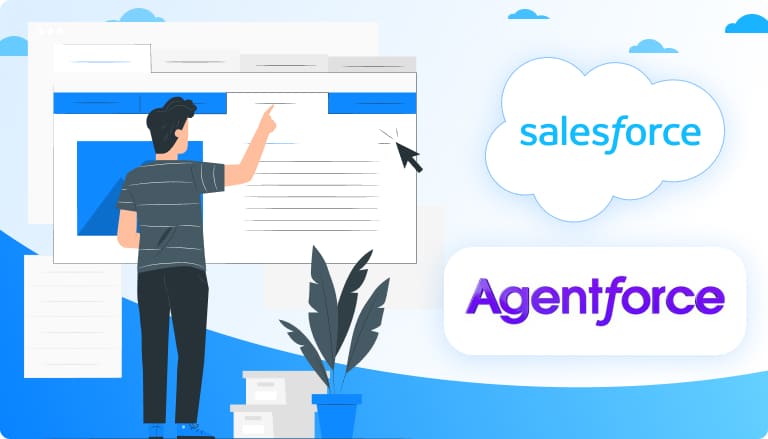
Introduction to Agentforce
“Gone are the days where a customer has to search and get transferred to a call center…Agentforce provides personalized answers customers need, when they need them,” Said Jim Roth, President, Customer Success, Salesforce.
You may have heard about Agentforce in the Salesforce world, but what exactly is it? Agentforce is a new AI tool from Salesforce that helps companies automate their internal support and case management tasks. It uses smart AI agents to handle work automatically, like sorting support tickets and taking action without needing someone to do it manually.
Agentforce is part of the Salesforce system and works alongside other AI tools like Einstein. While Einstein gives predictions and insights, Agentforce can actually perform tasks on its own, like updating records or sending follow-up messages. It can work across different Salesforce areas, such as Service Cloud and Sales Cloud, and even connect to other systems your company uses.
More than 200 major customers have already signed agreements with Salesforce to start using the new AI platform, Agentforce. Salesforce CEO Marc Benioff shared this news during the company’s latest quarterly earnings presentation.
Many companies are choosing Agentforce because it helps manage the large amount of support requests they get every day. For example, IT helpdesk tickets, HR questions, or facility requests can pile up and slow down the team. Agentforce sorts these cases, sends them to the right person, and can even solve some problems by itself. This saves time and reduces mistakes. Let’s take a look at some AI consumer insights:
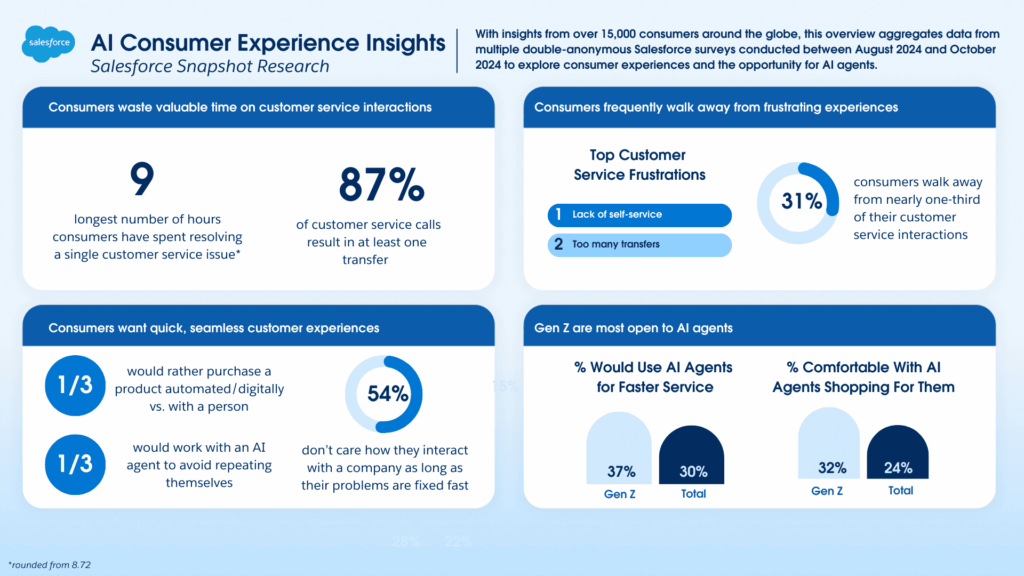
Agentforce implementation works well in many industries, and its flexible design makes it suitable for many industries, including:
- Financial Services: Automating compliance case management, IT support, and client onboarding requests.
- Healthcare: Managing patient support cases, HR inquiries, and facility maintenance tasks efficiently.
- Retail: Handling returns, customer service tickets, and employee support requests.
- Manufacturing: Streamlining internal IT and equipment maintenance requests.
If your company wants to get started with this tool, following a clear Salesforce Agentforce implementation guide will help you set it up the right way, avoiding common mistakes and saving time.
- Clouds Where Agentforce is Most Used
- Salesforce Agentforce Implementation Process
- Salesforce Agentforce Implementation Timeline
- Team Needed for Agentforce Implementation
- Salesforce Agentforce Implementation Challenges and Best Practices
- Reasons to Opt for Agentforce Integration Services
- Popular Agentforce Integrations
- FAQs on Salesforce Agentforce Implementation
- 1. How long does the implementation of Agentforce usually take?
- 2. Can I do everything without developers?
- 3. How do we measure success after implementation?
- 4. What happens if we change our workflows later?
- 5. How secure is the data processed by Agentforce?
- 6. What if our company uses multiple Salesforce clouds?
- 7. How do updates to Agentforce get managed?
- Wrapping Up: Your Agentforce Journey
Clouds Where Agentforce is Most Used
Agentforce is designed to work across many Salesforce Clouds, helping teams handle tasks faster and keep information up to date. Whether you use sales, marketing, service, or online commerce, Agentforce can fit into your daily work without needing big changes to existing processes. In the state of AgentExchange, you can find apps that extend Agentforce’s capabilities even further, making it easier to connect with tools your teams already rely on. Now, let’s see how it supports each cloud and what benefits it brings.
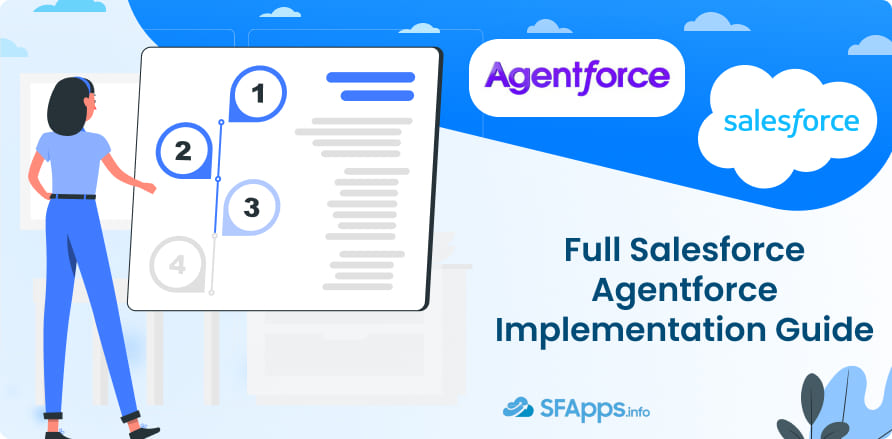
What Does Agentforce Do in the Service Cloud?
In Service Cloud, it helps teams handle customer support cases from start to finish. The Service Cloud Agentforce automatically sorts incoming requests, assigns them to the right people, and updates the status as work gets done. For example, if a customer submits a case about a product issue, the Salesforce Agentforce service agent can create the record, suggest solutions, and send follow-up messages without manual steps. This helps service teams keep up with demand and respond quickly. You can explore more here.
How Does It Support Marketing Cloud?
Agentforce for Marketing Cloud helps manage internal tasks related to campaigns and customer communications. It can route requests for content approvals, track campaign issues, and pull updated customer data into Marketing Cloud automatically. This keeps marketing records clean and makes sure teams have current information to plan and launch campaigns.
Agentforce for Sales Cloud
In Sales Cloud, Agentforce can handle parts of the sales process that often slow teams down. It tracks leads, updates records with the latest customer details, and sends reminders so nothing gets missed. For example, if a lead hasn’t been contacted in a few days, Agentforce can create a task or notify a sales rep to follow up. It also helps organize opportunity updates so sales managers can see progress clearly.
Experience Cloud and Commerce Cloud
Agentforce Experience Cloud can manage questions and requests from customer communities. It reviews posts, suggests helpful articles, and creates cases if personal support is needed. This helps community members find answers faster.
In the Commerce Cloud, Agentforce keeps an eye on orders and inventory. If there’s an issue with a payment or a return, it can create a case automatically and assign it to the right team. Agentforce for Commerce Cloud also tracks stock levels and flags items that need restocking or attention.
Agentforce in Data 360 (formerly – Data Cloud)
Data 360 collects customer data from different systems and keeps it updated in real time. Agentforce uses this information through Salesforce Agentforce Data 360 integration to see the most recent purchases, website visits, and service interactions. When Agentforce creates a case, updates a record, or sends a message, it relies on this complete and current view of each customer.
This rapid adoption marks Agentforce as one of the fastest-growing products in Salesforce’s history, even before full deployment across all geographies, currencies, and languages. And highlight the widespread interest and trust in Agentforce across various industries.
Insight:
Did you know that Salesforce has closed over 8,000 deals since launching Agentforce, of which half are paid, and nearly 60% of Q1 top 100 deals included Data 360 and AI?
These statistics were reported by CEO Marc Benioff during the company’s Q1 fiscal 2026 earnings call.
Agentforce has already reached over $100 million in average order value. It’s now the fastest growing product in Salesforce history, even though it’s still not available in every country, currency, or language.
Salesforce Agentforce Implementation Process
Setting up Agentforce in your environment takes careful planning and clear steps. The process is usually structured to help companies move from discovery to full deployment without missing important details. Whether you work with an implementation partner or handle the project internally, it’s important to follow each phase in order so your teams are ready to use Agentforce effectively.
Down is a step-by-step look at how a typical implementation works, along with the tools you may need along the way.
Discovery and Planning
The first stage is to define your goals and decide how Agentforce should fit into your workflows. Planning also includes selecting any additional Salesforce products you might need, like Data 360 or Marketing Cloud, to extend Agentforce’s capabilities. In this phase, you will:
- Identify which teams will use Agentforce (such as customer support, IT, or HR).
- List the main processes you want to automate, like case routing or ticket follow-ups.
- Review your current Salesforce setup to check for any gaps or technical requirements.
- Create a timeline and assign roles for the project team.
For example, your company wants to use Agentforce to manage customer support. You decide the Customer Support team with 25 agents will be the first group. You make a list of everyone who will need access, including team leads and the support operations manager. Next, you list the main processes to automate:
– Create a new case automatically when a customer’s email comes in.
– Assign the case based on product type (for example, “Software” or “Hardware”).
– Send an automatic confirmation email to the customer.
– Update the case status to “Closed” when the agent marks it resolved.
When you review your Salesforce setup, you find you need to add a custom field to track product categories and check that all agents have Service Cloud licenses. You assign your Salesforce Admin to handle configuration, your IT manager to review security, and your support operations manager to train the team.
Setup and Agentforce Configuration
Once planning is complete, the next step is installing and configuring Agentforce in your Salesforce org. This part involves several actions you can follow in order:
Step 1: Enabling Agentforce features.
Firstly, you need to make sure that the Einstein Generative AI is turned on. After, in Salesforce Setup, search for Agentforce in the Quick Find box. Click the Agentforce Agents. Here you can turn on the feature and create a new Agent.
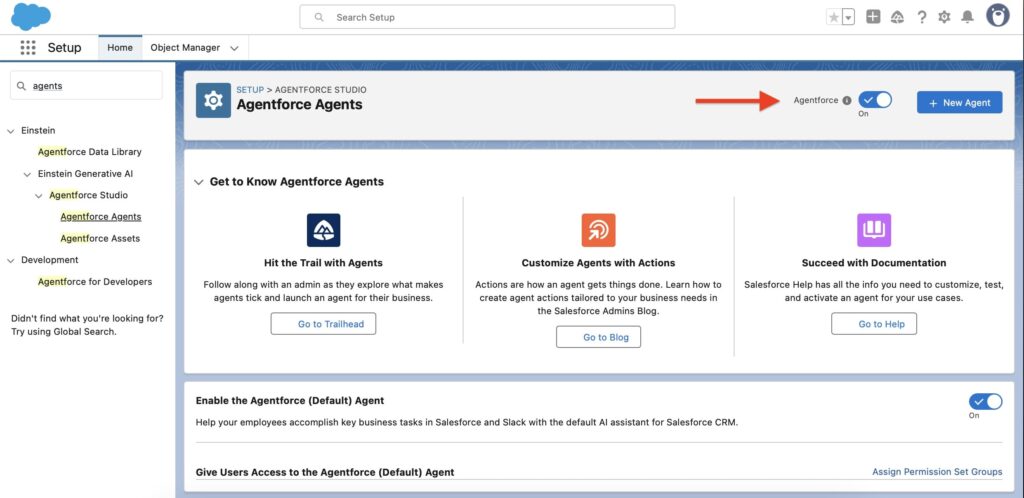
For more details, check out the official documentation here.
Step 2. Creating record types, fields, and custom objects if needed.
Navigate to Object Manager in Setup. Select the Case object (or any other object you want Agentforce to work with). Here, you can create record types for different categories of cases, add custom fields to track extra data, and build custom objects if your process needs them. For our scenario, we will create a picklist Product Category with values: Hardware, Software, and Other.
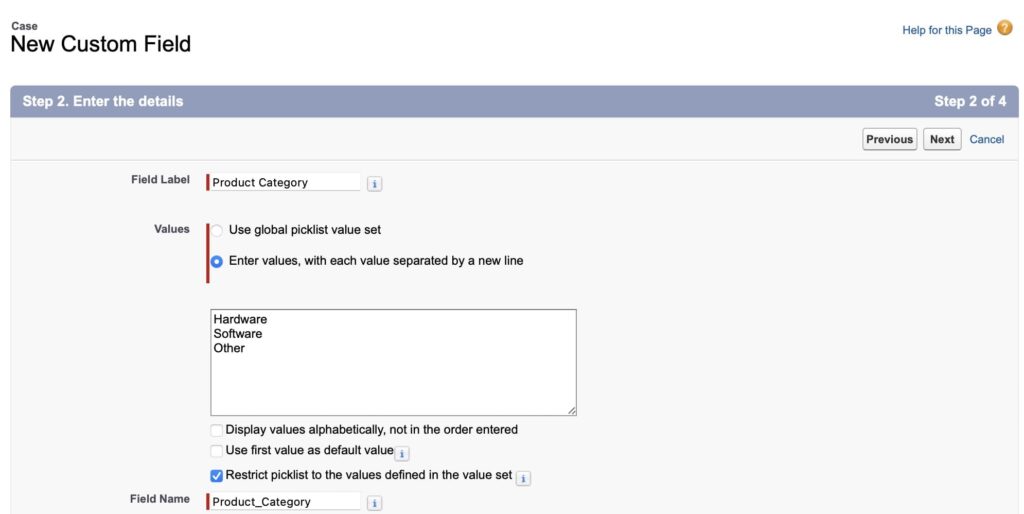
Step 3: Setting up AI prompts or configurations.
You can create prompts in Prompt Builder to guide how Agentforce processes incoming requests. For example, we will build a prompt that tells Agentforce to read the case description and decide whether the issue is related to Software, Hardware, or another product line. This makes it easier to assign the case to the right support team automatically.
Here’s how to set up a prompt:
- In Setup, search for Prompt Builder in the Quick Find box and open it.
- Click New Prompt.
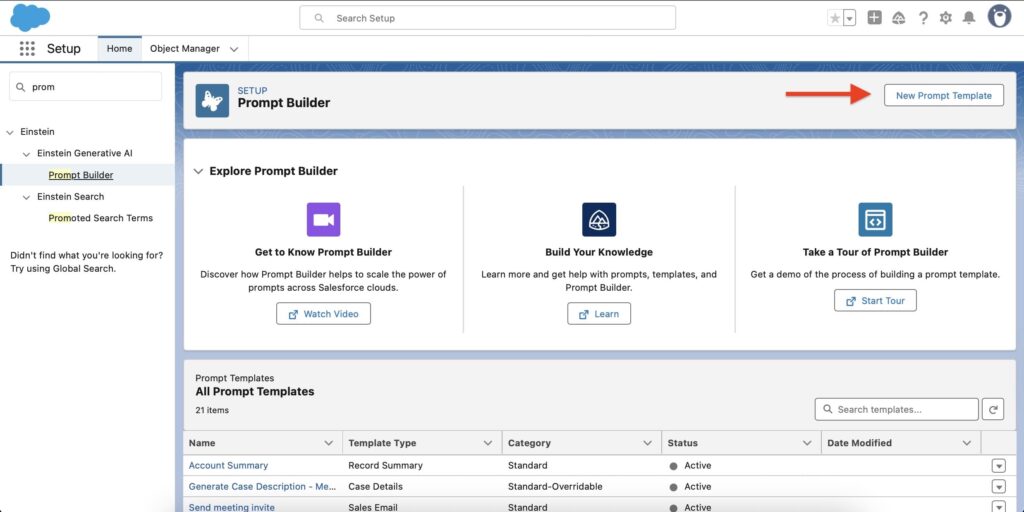
- In the Prompt Template Type dropdown, select Field Generation.
- Enter the Prompt Template Name, for example: Classify Case by Product Type.
- Enter an API Name, such as Classify_Case_Product_Type.
- Add a Template Description, like: “Assigns a Product Category value based on keywords in the case description.”
- Choose Case as the object.
- Then pick the Case Description field.
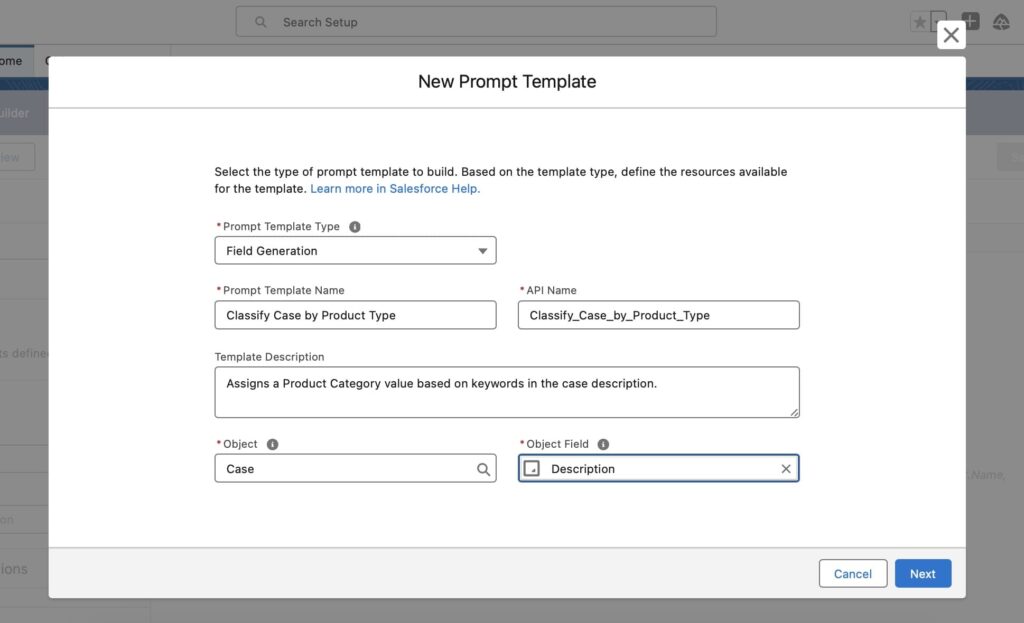
- Write a clear prompt for the AI, including as source Case Description. For our scenario, it will be: Read the {!$Input:Case.Description}. If the text contains any of these words: screen, device, battery, hardware error, equipment malfunction, return “Hardware.” If the text contains any of these exact words: install, update, license, software error, application failure, return “Software.” If no matches are found, return “Other.”
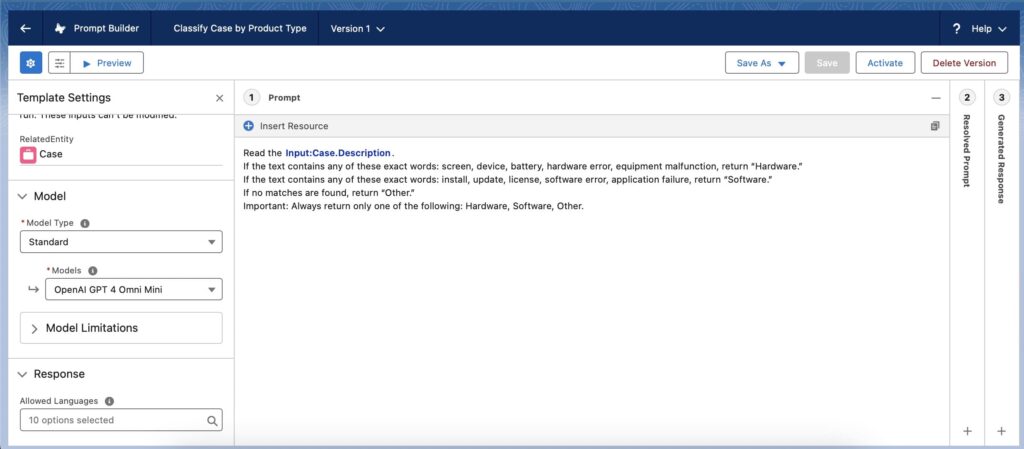
- Test and Preview: Input sample case descriptions and check that the AI returns the expected product category before activating the prompt.
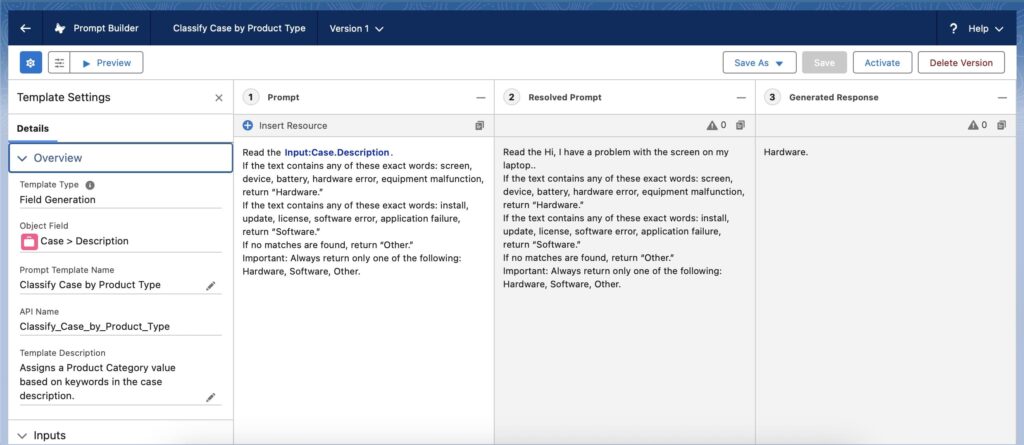
- Save and Activate: Once satisfied, save your prompt and activate it.
Step 4: Post-Launch Support
After Agentforce goes live, you’ll need a plan to monitor performance and address any issues quickly. This phase includes:
- Tracking performance: Review reports and dashboards to confirm cases are routed, categorized, and resolved as expected.
- Gathering feedback: Collect input from agents and managers to spot any gaps or confusion.
- Making adjustments: Update AI prompts, Flows, or configurations if real-world use shows something needs improvement.
- Training refreshers: Schedule follow-up sessions to help teams get comfortable and learn best practices.
- Ongoing maintenance: Assign an admin or support team to keep the setup current, especially as your business processes evolve.
Salesforce Agentforce Implementation Timeline
Rolling out Agentforce in your Salesforce environment doesn’t happen overnight. While every company’s schedule is unique, most implementations follow a similar timeline from planning to launch. This helps teams stay organized, track progress, and avoid delays.
Below is a typical implementation timeline, along with examples and factors that can speed things up or slow things down.
Estimated Timeline by Stage
- Discovery and Planning (1–2 weeks)
Define goals, list processes you want to automate and decide which teams will use Agentforce. Gather requirements, check licenses, and assign project roles. - Setup and Configuration (2–3 weeks)
Enable Agentforce features, set up AI prompts, create supporting fields and record types, and build Flows or Apex as needed. - Testing and Validation (1–2 weeks)
Try sample records, test AI prompts for accuracy, validate automation logic, and adjust configurations. - Training and User Readiness (1 week)
Train support teams, share documentation, and confirm everyone understands how to use the new tools. - Deployment and Go-Live (1 week)
Migrate any final configuration changes, activate prompts and Flows, and start using Agentforce in production.
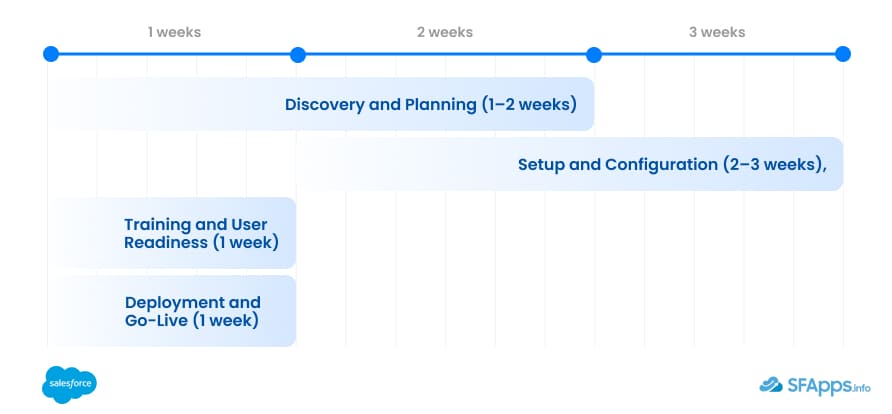
In our scenario, using Agentforce to manage customer support with a team of 25 agents, the implementation might look like this:
- Week 1-2: Discovery and Planning
- Gather requirements and map workflows
- Week 3-4: Setup and Configuration
- Enable Agentforce, create custom fields, and set up AI prompts
- Week 5: Testing and Validation
- Test sample cases and verify prompt responses
- Week 6: Training
- Train 25 support agents and team leads
- Week 7: Deployment and Go-Live
Factors That Influence Your Timeline
Keep in mind that several elements can make your Agentforce implementation timeline shorter or longer:
- Number of users: Larger teams need more training and coordination.
- Salesforce Clouds involved: If you connect Service Cloud, Data 360, or Marketing Cloud, setup takes more time.
- Integrations: Linking Agentforce to external systems or legacy tools adds extra steps.
- Custom development: If you plan to use Apex or complex Flows, expect additional build time.
- Change management: Preparing teams and communicating changes can add to your schedule.
Team Needed for Agentforce Implementation
Successfully implementing Agentforce requires a strong, skilled team that covers technical setup, process design, and project management. The right mix of experts ensures the project runs smoothly and meets your company’s unique needs.
Having team members with specific Salesforce and Agentforce knowledge is especially important because this solution combines AI, automation, and integration capabilities.
Key Roles in Your Implementation Team
- Salesforce Admins
Admins handle configuration inside Salesforce, set up objects, fields, user permissions, and manage declarative automation like Flows. Their deep knowledge of the org is essential for a smooth rollout. - Developers
Developers write custom Apex code or build complex integrations when standard tools are not enough. Their expertise helps extend Agentforce functionality or connect it with external systems. - Consultants
Experienced consultants guide your team on best practices and help align Agentforce with your business processes. They often have hands-on experience deploying AI solutions in Salesforce environments. - Project Managers
PMs coordinate timelines, resources, and communications. Their role is to keep the project on track and ensure all stakeholders are informed and engaged. - Agentforce Integration Specialists
Integration specialists focus on connecting Agentforce with other Salesforce clouds or third-party systems. Their skills are critical if you plan to sync data across platforms or extend capabilities.
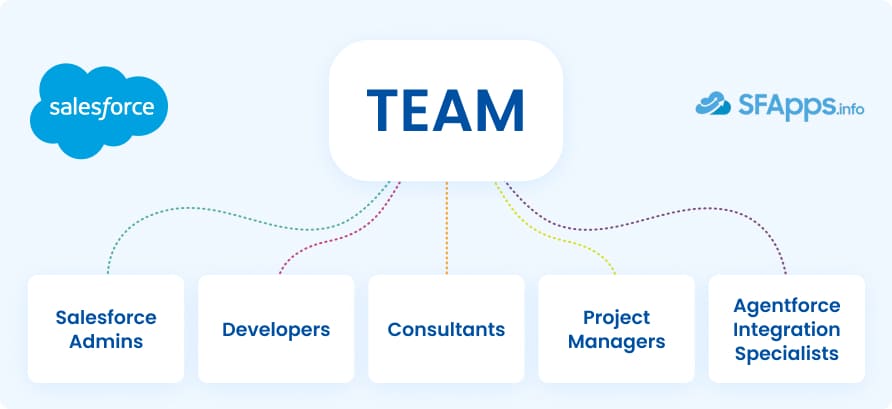
Important Qualifications and Certifications
- The Salesforce Certified Agentforce Specialist credential is becoming a key qualification for those leading or deeply involved in Agentforce projects. This certification shows mastery in configuring and managing Agentforce solutions. You’ll also benefit from having a Salesforce Agentforce specialist on your team who can design AI workflows and ensure compliance with your company’s standards.
- Practical experience with AI prompt creation, automation, and Salesforce data modeling is just as valuable. Team members should understand how to design flows and AI-driven processes that fit business goals.
- When looking for Agentforce implementation experts, prioritize candidates who have both Salesforce certifications and a solid track record with AI and integration projects.
Salesforce Agentforce Implementation Challenges and Best Practices
Even with a strong plan, some teams run into problems while deploying Agentforce. Recognizing the most common issues in advance can help you avoid delays, rework, or frustration later on. Below, you’ll find the top challenges and Salesforce Agentforce implementation best practices to handle each one. Use this list as a guide to keep your project on track from planning to go-live.
Challenge #1: Misalignment with Existing Workflows
Agentforce often requires you to rethink how cases are created, routed, and resolved. If you don’t review and update your existing workflows first, you can end up with duplicate processes or gaps in case handling.
Best Practice: Before setup, map out your current workflows in detail. Compare them to Agentforce capabilities to see what should stay the same and what needs to change. Involve team leads early so everyone understands the future process.
Challenge #2: Poor Data Preparation
Agentforce relies on accurate, structured data to work well. If your records have missing fields, inconsistent formats, or outdated entries, AI prompts and automations may fail or produce the wrong results.
Best Practice: Clean your data before implementation. Standardize field values, remove duplicates, and make sure the required information is complete. Consider running small tests with sample records to confirm the data performs as expected.
Challenge #3: Lack of Internal Training
Even the best setup won’t deliver results if your team doesn’t understand how to use it. Many companies underestimate the time it takes to train users and get everyone comfortable with the new tools.
Best Practice: Plan a dedicated training period before going live. Use short guides, recorded demos, and live Q&A sessions to show teams how Agentforce fits into their daily work. Assign internal champions who can answer questions and help troubleshoot in the first few weeks.
Challenge #4: Overcomplicating Configuration
It’s tempting to build every possible automation or prompt during the initial rollout. However, complex setups can overwhelm users and increase maintenance headaches.
Best Practice: Start with a small, focused scope. Choose 2–3 high-impact workflows to automate first. Once your team is comfortable, expand gradually. This approach makes it easier to adjust and improves adoption rates.
Challenge #5: Insufficient Testing
Rushing from setup straight to production without thorough testing is a common mistake. Errors in AI prompts or record updates can create confusion and slow down your team.
Best Practice: Always run a testing phase with real scenarios and sample records. Validate AI outputs, confirm that automations trigger correctly, and get feedback from end users. Fix any issues before you go live.
Reasons to Opt for Agentforce Integration Services
While some companies try to handle Agentforce projects entirely in-house, many find that partnering with experienced consultants delivers better results. Working with a dedicated integration team brings specialized knowledge, speeds up delivery, and reduces costly mistakes. Below are the top reasons why Salesforce Agentforce integration services can make a big difference:
1. Time Savings
An Agentforce implementation partner already knows the most efficient ways to set up Agentforce. They can help you avoid trial and error by following proven methods, so your project moves faster from planning to launch.
2. Expertise and Certifications
Specialists often hold relevant credentials, like Salesforce Certified Agentforce Specialist, and have experience configuring AI prompts, automations, and integrations across multiple industries.
3. Smoother Delivery
Partners provide structured project plans, clear timelines, and well-documented steps. This consistency reduces confusion among your internal teams and helps ensure no critical details are missed.
4. Lower Error Rates
Agentforce integration specialists have seen what goes wrong in other deployments. They can identify potential problems early and build safeguards so your workflows perform as expected.
What to Look for in an Agentforce Integration Partner
When you’re evaluating potential partners, consider these factors:
- Relevant Experience: Have they delivered Agentforce projects similar to yours?
- Certifications: Are they recognized as Agentforce implementation experts with strong Salesforce credentials?
- References: Can they share success stories or client testimonials?
- Support Options: Do they provide post-launch support and training?
- Project Approach: Will they create a clear plan with timelines and milestones?
- Communication: Do they offer regular updates and accessible points of contact?
Popular Agentforce Integrations
One of the biggest advantages of Agentforce is how easily it connects with other tools your teams already rely on. Any Agentforce AI integration or popular Salesforce integrations help you extend capabilities, improve communication, and deliver faster service without switching between systems. Let’s take a look:
Slack
With Agentforce Slack integration, you can automatically send alerts to channels or direct messages when important events happen. For example, when a high-priority case is created, Agentforce can post an update to your support team’s Slack channel so everyone is aware right away. This keeps conversations and case updates in one place, speeding up response times.
MuleSoft
Agentforce MuleSoft integration connects Salesforce with data from other platforms, such as ERP systems, customer databases, or billing applications. When you combine MuleSoft and Agentforce, you can pull relevant customer records or transaction details into a case automatically. This ensures agents have the right context without needing to look up data in multiple systems. You can find more information here.
Many customers prefer to get help over messaging apps. With Agentforce WhatsApp integration, you can let customers open cases, receive updates or ask questions directly through WhatsApp. Agentforce can then log these conversations in Salesforce, trigger automations, and even send follow-up messages once the issue is resolved. This creates a convenient experience for customers and reduces the time spent managing communication across channels.
FAQs on Salesforce Agentforce Implementation
Here are some of the most Salesforce Agentforce frequently asked questions that teams ask before they start their Salesforce Agentforce journey:
1. How long does the implementation of Agentforce usually take?
Timelines depend on your goals, data complexity, and team size. A focused implementation can take from 4 to 6 weeks, while large projects with multiple clouds and Agentforce Salesforce integration often require 2-3 months. A clear roadmap and regular testing help avoid delays.
2. Can I do everything without developers?
Some parts of implementation can be handled by Salesforce Admins using declarative tools. But if you need specific Agentforce integration or custom automations, working with developers or Agentforce specialists is recommended.
3. How do we measure success after implementation?
Most companies track metrics such as:
- Case resolution time
- Number of automated actions
- Customer satisfaction scores
- Agent workload reduction
Setting baseline benchmarks before launch makes it easier to see improvements later.
4. What happens if we change our workflows later?
Agentforce is built to be flexible. You can adjust prompts, automations, and record structures as your processes evolve. Just be sure to test changes in a sandbox first to avoid disruptions.
5. How secure is the data processed by Agentforce?
Agentforce follows Salesforce’s robust security model, including data encryption, user permissions, and compliance standards. It respects your org’s security settings and doesn’t bypass existing controls.
6. What if our company uses multiple Salesforce clouds?
Agentforce is designed to work across Salesforce clouds like Service Cloud, Marketing Cloud, and Experience Cloud. Integrations and workflows can be customized to fit your setup.
7. How do updates to Agentforce get managed?
Salesforce regularly updates Agentforce with new features and fixes. These updates are typically seamless, but you should review release notes and test changes before applying them to your production environment.
Wrapping Up: Your Agentforce Journey
We hope that this guide has covered everything you need to know about Agentforce: from what it is and how it fits in Salesforce, to the implementation process, common challenges, key integrations, and who should be involved.
Implementing Agentforce can transform your internal support by automating tasks, improving case handling, and using AI to assist your teams. Success comes with careful planning, clean data, thoughtful setup, and ongoing support.
Whether you take on the project internally or work with specialists, focusing on your company’s unique needs will help you get the best results.
If you’re ready to start or want expert advice, feel free to reach out. Agentforce has great potential, and with the right approach, it can make a real difference for your business.

Antonina is a Salesforce Admin with six certifications: Salesforce Certified Platform Foundations, Platform Administrator, Platform Administrator II, CPQ Administrator, AI Associate, and Agentforce Specialist. She started working with Salesforce in 2021 as Intern Salesforce Developer. Now, a 2-Star Ranger on Trailhead, she continues to expand her skills and knowledge. She helps manage Salesforce systems, automate tasks, and improve processes. Antonina loves learning new things and exploring better ways to use technology. In her free time, she enjoys reading, playing sports, and exploring new tech ideas.

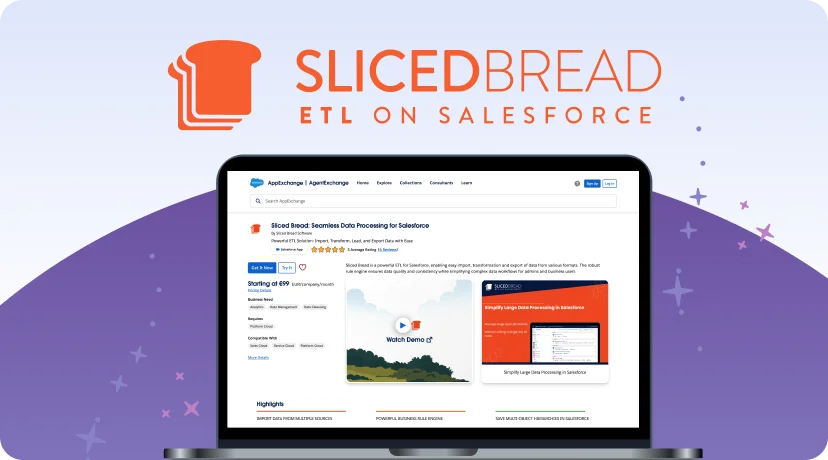
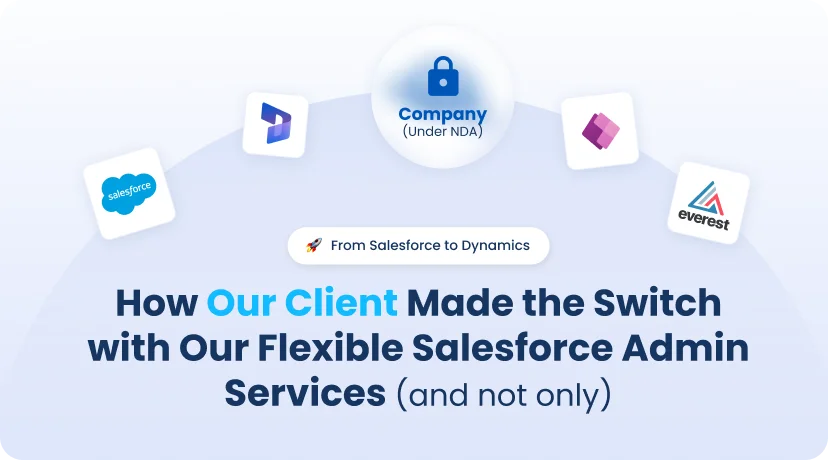
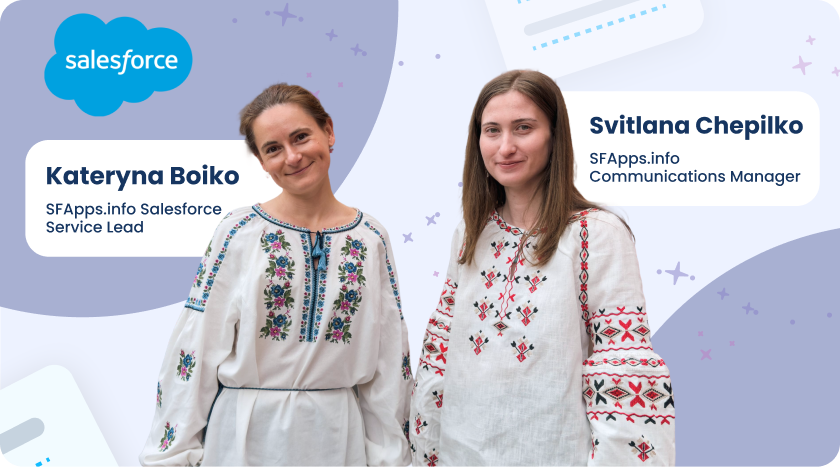

 Previous Post
Previous Post Next Post
Next Post